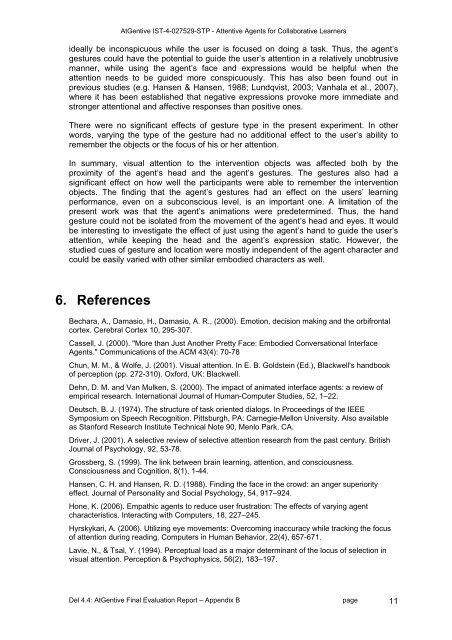Deliverable 4.4 - INSEAD CALT
Deliverable 4.4 - INSEAD CALT
Deliverable 4.4 - INSEAD CALT
Create successful ePaper yourself
Turn your PDF publications into a flip-book with our unique Google optimized e-Paper software.
AtGentive IST-4-027529-STP - Attentive Agents for Collaborative Learnersideally be inconspicuous while the user is focused on doing a task. Thus, the agent’sgestures could have the potential to guide the user’s attention in a relatively unobtrusivemanner, while using the agent’s face and expressions would be helpful when theattention needs to be guided more conspicuously. This has also been found out inprevious studies (e.g. Hansen & Hansen, 1988; Lundqvist, 2003; Vanhala et al., 2007),where it has been established that negative expressions provoke more immediate andstronger attentional and affective responses than positive ones.There were no significant effects of gesture type in the present experiment. In otherwords, varying the type of the gesture had no additional effect to the user’s ability toremember the objects or the focus of his or her attention.In summary, visual attention to the intervention objects was affected both by theproximity of the agent’s head and the agent’s gestures. The gestures also had asignificant effect on how well the participants were able to remember the interventionobjects. The finding that the agent’s gestures had an effect on the users’ learningperformance, even on a subconscious level, is an important one. A limitation of thepresent work was that the agent’s animations were predetermined. Thus, the handgesture could not be isolated from the movement of the agent’s head and eyes. It wouldbe interesting to investigate the effect of just using the agent’s hand to guide the user’sattention, while keeping the head and the agent’s expression static. However, thestudied cues of gesture and location were mostly independent of the agent character andcould be easily varied with other similar embodied characters as well.6. ReferencesBechara, A., Damasio, H., Damasio, A. R., (2000). Emotion, decision making and the orbifrontalcortex. Cerebral Cortex 10, 295-307.Cassell, J. (2000). "More than Just Another Pretty Face: Embodied Conversational InterfaceAgents." Communications of the ACM 43(4): 70-78Chun, M. M., & Wolfe, J. (2001). Visual attention. In E. B. Goldstein (Ed.), Blackwell's handbookof perception (pp. 272-310). Oxford, UK: Blackwell.Dehn, D. M. and Van Mulken, S. (2000). The impact of animated interface agents: a review ofempirical research. International Journal of Human-Computer Studies, 52, 1–22.Deutsch, B. J. (1974). The structure of task oriented dialogs. In Proceedings of the IEEESymposium on Speech Recognition. Pittsburgh, PA: Carnegie-Mellon University. Also availableas Stanford Research Institute Technical Note 90, Menlo Park, CA.Driver, J. (2001). A selective review of selective attention research from the past century. BritishJournal of Psychology, 92, 53-78.Grossberg, S. (1999). The link between brain learning, attention, and consciousness.Consciousness and Cognition, 8(1), 1-44.Hansen, C. H. and Hansen, R. D. (1988). Finding the face in the crowd: an anger superiorityeffect. Journal of Personality and Social Psychology, 54, 917–924.Hone, K. (2006). Empathic agents to reduce user frustration: The effects of varying agentcharacteristics. Interacting with Computers, 18, 227–245.Hyrskykari, A. (2006). Utilizing eye movements: Overcoming inaccuracy while tracking the focusof attention during reading. Computers in Human Behavior, 22(4), 657-671.Lavie, N., & Tsal, Y. (1994). Perceptual load as a major determinant of the locus of selection invisual attention. Perception & Psychophysics, 56(2), 183–197.Del <strong>4.4</strong>: AtGentive Final Evaluation Report – Appendix B page 11
















